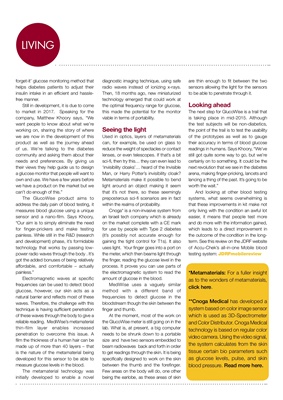
LIVINGLIVING
forget-it' glucose monitoring method that
helps diabetes patients to adjust their
insulin intake in an efficient and hasslefree
manner.
Still in development, it is due to come
to market in 2017. Speaking for the
company, Matthew Khoory says, "We
want people to know about what we're
working on, sharing the story of where
we are now in the development of this
product as well as the journey ahead
of us. We're talking to the diabetes
community and asking them about their
needs and preferences. By giving us
their views they help guide us to design
a glucose monitor that people will want to
own and use. We have a few years before
we have a product on the market but we
can't do enough of this."
The GlucoWise product aims to
address the daily pain of blood testing, it
measures blood glucose using a unique
sensor and a nano-film. Says Khoory,
"Our aim is to simply eliminate the need
for finger-prickers and make testing
painless. While still in the R&D (research
and development) phase, it's formidable
technology that works by passing lowpower radio waves through
the body . It's
got the added bonuses of being relatively
affordable, and comfortable - actually
painless."
Electromagnetic waves at specific
frequencies can be used to detect blood
glucose, however, our skin acts as a
natural barrier and reflects most of these
waves. Therefore, the challenge with this
technique is having sufficient penetration
of these waves through the body to give a
reliable reading. MediWise's metamaterial
thin-film layer enables increased
penetration to overcome this issue. A
film the thickness of a human hair can be
made up of more than 40 layers - that
is the nature of the metamaterial being
developed for this sensor to be able to
measure glucose levels in the blood.
The metamaterial technology was
initially developed to enable a novel
diagnostic imaging technique, using safe
radio waves instead of ionizing x-rays.
Then, 18 months ago, new miniaturized
technology emerged that could work at
the optimal frequency range for glucose,
this made the potential for the monitor
viable in terms of portability.
Seeing the light
Used in optics, layers of metamaterials
can, for example, be used on glass to
reduce the weight of spectacles or contact
lenses, or even telescopes. If that's a bit
sci-fi, then try this… they can even lead to
'invisibility cloaks'… heard of the Invisible
Man, or Harry Potter's invisibility cloak?
Metamaterials make it possible to bend
light around an object making it seem
that it's not there, so these seemingly
preposterous sci-fi scenarios are in fact
within the realms of probability.
Cnoga* is a non-invasive system from
an Israeli tech company which is already
on the market complete with a CE mark
for use by people with Type 2 diabetes
(it's possibly not accurate enough for
gaining the tight control for T1s). It also
uses light. Your finger goes into a port on
the meter, which then beams light through
the finger, reading the glucose level in the
process. It proves you can use parts of
the electromagnetic system to read the
amount of glucose in the blood.
MediWise uses a vaguely similar
method with a different band of
frequencies to detect glucose in the
bloodstream though the skin between the
finger and thumb.
At the moment, most of the work on
the GlucoWise meter is still going on in the
lab. What is, at present, a big computer
needs to be shrunk down to a portable
size and have two sensors embedded to
beam radiowaves back and forth in order
to get readings through the skin. It is being
specifically designed to work on the skin
between the thumb and the forefinger.
Few areas on the body will do, one other
being the earlobe, as these areas of skin
*Metamaterials: For a fuller insight
as to the wonders of metamaterials,
click here.
**Cnoga Medical has developed a
system based on color image sensor
which is used as 3D-Spectrometer
and Color Distributor. Cnoga Medical
technology is based on regular color
video camera. Using the video signal,
the system calculates from the skin
tissue certain bio parameters such
as glucose levels, pulse, and skin
blood pressure. Read more here.
are thin enough to fit between the two
sensors allowing the light for the sensors
to be able to penetrate through it.
Looking ahead
The next step for GlucoWise is a trail that
is taking place in mid-2015. Although
the test subjects will be non-diabetics,
the point of the trail is to test the usability
of the prototypes as well as to gauge
their accuracy in terms of blood glucose
readings in humans. Says Khoory, "We've
still got quite some way to go, but we're
certainly on to something. It could be the
next revolution that we see in the diabetes
arena, making finger-pricking, lancets and
lancing a thing of the past. It's going to be
worth the wait."
And looking at other blood testing
systems, what seems overwhelming is
that these improvements in kit make not
only living with the condition an awful lot
easier, it means that people test more
and do more with the information gained,
which leads to a direct improvement in
the outcome of the condition in the longterm.
See this review on the JDRF website
of Accu-Chek's all-in-one Mobile blood
testing system: JDRFmobilereview